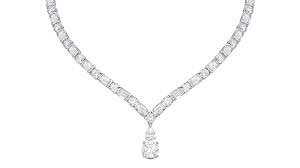
Lab-Grown Diamond
In recent years, lab-grown diamonds have transformed the jewelry industry, offering an ethical, sustainable, and affordable alternative to natural diamonds. Among various jewelry pieces, lab-grown diamond necklaces have gained significant popularity for their brilliance, quality, and eco-friendly appeal. This article explores what lab-grown diamonds are, the technology behind them, their advantages, how lab-grown diamond necklaces compare to traditional diamond jewelry, and why they are becoming the preferred choice for consumers worldwide.
What Are Lab-Grown Diamonds?
Lab-grown diamonds, also known as synthetic or man-made diamonds, are diamonds created in controlled laboratory environments. Unlike imitation diamonds such as cubic zirconia or moissanite, lab-grown diamonds are chemically, physically, and optically identical to natural diamonds formed deep within the Earth over millions of years.
Two main processes produce lab-grown diamonds:
- High Pressure High Temperature (HPHT): This method mimics natural diamond formation by applying intense pressure and heat to carbon materials.
- Chemical Vapor Deposition (CVD): This technique involves breaking down carbon-rich gases into carbon atoms, which then crystallize on a diamond seed in a vacuum chamber.
Both methods result in real diamonds, certified by gemological labs and indistinguishable from natural diamonds without specialized equipment.
Advantages of Lab-Grown Diamonds
Lab-grown diamonds come with a host of benefits, especially when used in necklaces:
- Ethical Sourcing: Natural diamond mining can sometimes involve exploitative labor practices and conflict zones. Lab-grown diamonds eliminate these concerns as they are created in controlled environments with transparent supply chains.
- Environmental Impact: Mining natural diamonds requires large-scale excavation, causing deforestation, soil erosion, and significant carbon emissions. Lab-grown diamonds have a much smaller environmental footprint, requiring less energy and land use.
- Cost-Effectiveness: Lab-grown diamonds typically cost 30-40% less than natural diamonds of comparable size and quality. This price advantage allows consumers to purchase larger or higher-quality stones within their budget.
- Quality and Variety: Lab-grown diamonds can be engineered with fewer impurities and offer a range of colors, sizes, and shapes, providing more customization options for necklaces.
Why Choose a Lab-Grown Diamond Necklace?
Necklaces are a timeless accessory, often chosen to commemorate special moments or express personal style. Opting for a lab-grown diamond necklace offers unique benefits:
- Brilliance and Beauty: Lab-grown diamonds possess the same optical properties as natural diamonds, showcasing stunning brilliance and fire, making necklaces sparkle in any light.
- Customization: Jewelry designers can create intricate designs and settings with lab-grown diamonds due to their availability and consistent quality. From delicate solitaire pendants to statement pieces, there is a lab-grown diamond necklace for every taste.
- Sustainability Statement: Wearing a lab-grown diamond necklace is a conscious choice that reflects awareness of environmental and social issues, resonating with modern consumers who value responsible luxury.
- Investment in Innovation: Lab-grown diamond necklaces symbolize technological advancement and innovation in the jewelry industry, blending tradition with modern science.
Comparing Lab-Grown and Natural Diamond Necklaces
One common question consumers have is whether lab-grown diamond necklaces are “real” or if they differ significantly from natural diamond necklaces. Here’s a detailed comparison:
| Feature | Lab-Grown Diamond Necklace | Natural Diamond Necklace |
|---|---|---|
| Composition | Chemically and physically identical | Naturally formed over millions of years |
| Price | Generally 30-40% less expensive | Higher due to rarity and mining costs |
| Environmental Impact | Lower carbon footprint, sustainable | Higher due to mining and land disruption |
| Ethical Concerns | Transparent, conflict-free | Potential risk of conflict or unethical mining |
| Availability | More consistent, customizable | Limited by natural supply |
| Certification | Certified by labs like IGI, GIA | Certified by same gemological labs |
Both types of necklaces hold their charm and value, but lab-grown diamonds provide a compelling alternative for ethical and budget-conscious buyers.
Design Trends in Lab-Grown Diamond Necklaces
Lab-grown diamond necklaces are available in a wide range of styles, appealing to diverse preferences:
- Solitaire Pendants: A single lab-grown diamond set in gold or platinum, offering timeless elegance suitable for everyday wear or special occasions.
- Halo Designs: A central lab-grown diamond surrounded by smaller stones to amplify sparkle and create a vintage or luxurious look.
- Layered Necklaces: Combining multiple chains and pendants with lab-grown diamonds for a trendy, personalized appearance.
- Colored Diamond Necklaces: Lab-grown diamonds can be produced in various hues such as pink, yellow, and blue, enabling unique colored diamond necklaces that stand out.
- Minimalist Styles: Sleek and modern designs featuring small lab-grown diamonds that add subtle shimmer, perfect for minimalistic fashion lovers.
How to Choose the Perfect Lab-Grown Diamond Necklace
When selecting a lab-grown diamond necklace, consider the following factors:
- Diamond Quality (The 4 Cs): Cut, clarity, color, and carat weight determine the diamond’s brilliance and value. Look for well-cut stones with minimal inclusions and a color grade that suits your preference.
- Metal Type: Popular choices include white gold, yellow gold, rose gold, and platinum. Your choice should complement your skin tone and personal style.
- Setting Style: Prong settings showcase the diamond prominently, while bezel settings offer protection and a sleek look.
- Certification: Always purchase lab-grown diamonds with certification from recognized gemological labs like IGI or GIA to ensure authenticity and quality.
- Brand Reputation: Choose reputable jewelers specializing in lab-grown diamonds for guaranteed quality and customer support.
Care and Maintenance of Lab-Grown Diamond Necklaces
Lab-grown diamonds are durable and suitable for daily wear, but proper care ensures longevity:
- Cleaning: Use mild soap and warm water with a soft brush to clean your necklace regularly. Ultrasonic cleaners are also safe for lab-grown diamonds.
- Storage: Keep the necklace in a separate jewelry box or pouch to avoid scratches from other pieces.
- Professional Checkups: Have your necklace inspected by a jeweler annually to check for loose settings or damage.
The Future of Lab-Grown Diamond Necklaces
As consumer awareness grows, the market for lab-grown diamonds is expanding rapidly. Advances in technology are making the production process more efficient and environmentally friendly. Designers are experimenting with innovative styles that maximize the beauty of lab-grown diamonds.
Several luxury brands have launched dedicated lab-grown diamond collections, signaling mainstream acceptance. As prices continue to become more competitive, lab-grown diamond necklaces are expected to become a staple in jewelry collections worldwide.
Conclusion
Lab-grown diamond necklaces offer a brilliant fusion of beauty, ethics, and innovation. They present a sustainable, affordable alternative to natural diamonds without compromising on quality or elegance. Whether as a gift, a personal treat, or a fashion statement, lab-grown diamond necklaces symbolize modern values and timeless style.
Choosing a lab-grown diamond necklace means embracing a future where luxury aligns with responsibility and technology enhances tradition. As this industry continues to evolve, the yellow brilliance of lab-grown diamonds will undoubtedly continue to light up necklaces and hearts around the globe.






